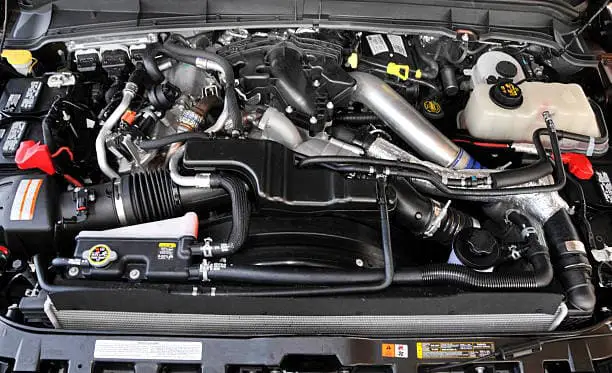The proper management of engine oil is essential to ensure the reliable performance and longevity of any vehicle’s engine, and the 6.7 Powerstroke engine is no exception. A crucial aspect of this maintenance is understanding the 6.7 Powerstroke oil capacity – the precise volume of oil required to maintain optimal lubrication, cooling, and protection of its internal components.
The 6.7 Powerstroke engine, commonly found in heavy-duty trucks and commercial vehicles, boasts impressive power and torque figures, making it a workhorse in various demanding applications. To keep this powerhouse running smoothly, it’s imperative to delve into the specifics of the 6.7 Powerstroke oil capacity.
This comprehensive exploration will delve into the nuances of the 6.7 Powerstroke oil capacity, addressing how it varies across different model years, understanding its role in engine health, and the implications of maintaining proper oil levels for performance and reliability.
Table of Contents
How Much Is the 6.7 Powerstroke Oil Capacity?
The term “6.7 Powerstroke” typically refers to the 6.7-liter V8 diesel engine that Ford has used in its Super Duty trucks since 2011.
The 6.7 Powerstroke oil capacity is an important specification to know when performing an oil change or maintaining the engine’s lubrication system.
The typical 6.7 Powerstroke oil capacity is around 15 to 16 quarts (approximately 14 to 15 liters). Below is the 6.7 Powerstroke oil capacity by model year:
- 2011-2014: The 6.7 Powerstroke oil capacity in Ford Super Duty trucks from 2011 to 2014 is approximately 15 quarts (14.2 liters). This 6.7 Powerstroke oil capacity includes both the engine oil in the crankcase and the oil filter.
- 2015-2016: For model years 2015 and 2016, the 6.7 Powerstroke oil capacity remains consistent at around 15 quarts (14.2 liters). This applies to the 6.7 Powerstroke engine in these years.
- 2017-2019: The 6.7 Powerstroke oil capacity in Ford Super Duty trucks from 2017 to 2019 is also around 15 quarts (14.2 liters). This includes the oil in the crankcase and the oil filter.
- 2020-Present: The 6.7 Powerstroke oil capacity in recent model years (2020 and later) is still around 15 to 16 quarts (14.2 to 15.1 liters), similar to the previous years.
What are the Oil Types for the 6.7 Powerstroke Engine?
After knowing the 6.7 Powerstroke oil capacity, let’s now find out the recommended oil types for the engine. The recommended oil type for the 6.7 Powerstroke engine is crucial for maintaining optimal engine performance, efficiency, and longevity.
The 6.7 Powerstroke engine generally requires diesel engine oils that meet specific industry standards. Some of the key details about the oil types for the 6.7 Powerstroke engine include:
1. Viscosity Rating
The first thing to consider is the viscosity rating of the oil. Viscosity refers to the oil’s resistance to flow. For the 6.7 Powerstroke engine, the most commonly recommended viscosity grade is 15W-40.
The “15W” indicates the oil’s viscosity characteristics at colder temperatures (W stands for “winter”), and the “40” represents its viscosity at operating temperatures. This viscosity range ensures proper oil flow during cold starts and sufficient lubrication under normal operating conditions.
2. API Rating
The American Petroleum Institute (API) has developed a classification system that rates oils based on their performance characteristics. For the 6.7 Powerstroke engine, look for oils with the API CJ-4 or CK-4 rating. These ratings indicate that the oil meets the latest standards for modern diesel engines, including emission control systems.
3. Synthetic vs. Conventional Oils
Both synthetic and conventional oils can be suitable for the 6.7 Powerstroke engine, but synthetic oils generally offer improved performance and protection, especially in extreme conditions. Synthetic oils have a more uniform molecular structure, providing better resistance to breakdown under high temperatures and extended use.
4. Oil Additives and Performance Features
Look for oils that include additives and features designed to enhance engine performance and protection. Some oils are formulated with detergents to keep the engine clean, antioxidants to prevent oxidation, and anti-wear additives to protect critical engine components.
5. OEM Recommendations
It’s recommended to use engine oils that meet the specifications outlined by the vehicle manufacturer. Ford provides specific recommendations for the 6.7 Powerstroke engine in the owner’s manual or official service documentation. Following these recommendations ensures that you’re using an oil that’s been tested and approved for your engine.
When choosing an oil for your 6.7 Powerstroke engine, it’s important to:
- Check the Owner’s Manual: Consult your vehicle’s owner’s manual for the exact oil specifications, including viscosity grade, API rating, and any other requirements.
- Use Reputable Brands: Choose well-known and reputable oil brands that meet the recommended specifications. These oils are more likely to have consistent quality and performance.
- Consider Operating Conditions: If you frequently tow heavy loads or operate in extreme conditions, such as high temperatures or cold climates, you might want to choose an oil with enhanced performance features.
- Follow Maintenance Intervals: Adhere to the recommended oil change intervals outlined in the owner’s manual. Regular oil changes are essential for maintaining the health of the engine.
Remember that oil specifications can change over time, so it’s a good practice to refer to your vehicle’s most recent documentation or consult a trusted mechanic for the latest information on oil types and recommendations for the 6.7 Powerstroke engine.
How Often Should You Change the Oil for the 6.7 Powerstroke Engine?
Oil change intervals for the 6.7 Powerstroke engine, like any other vehicle, depend on several factors including the type of oil you’re using, your driving conditions, and the manufacturer’s recommendations. Below is a comprehensive guide to how often you should change the oil for the 6.7 Powerstroke engine:
1. Follow the Manufacturer’s Recommendations
The most reliable source for oil change intervals is your vehicle’s owner’s manual. Ford provides specific guidelines for the 6.7 Powerstroke engine’s oil change intervals based on normal driving conditions and other considerations. This information can vary depending on the model year of your truck and any updates made.
2. Normal vs. Severe Driving Conditions
Oil change intervals are often divided into two categories: normal and severe driving conditions. Severe conditions can include frequent towing, driving in extreme temperatures (both hot and cold), frequent stop-and-go traffic, and driving in dusty or off-road environments. If you regularly operate under severe conditions, you may need to change the oil more frequently.
3. Synthetic vs. Conventional Oil
Synthetic oils generally have better temperature stability and overall performance, which can extend the oil change interval. Many modern engines, including the 6.7 Powerstroke, may have longer recommended intervals when using synthetic oils. However, it’s crucial to still follow the manufacturer’s recommendations.
4. Oil Monitoring Systems
Some modern vehicles, including certain versions of the 6.7 Powerstroke, are equipped with oil monitoring systems that analyze driving conditions, engine load, and other factors to determine when an oil change is necessary. These systems can provide more accurate intervals based on real-time data.
5. Consider Your Usage
If you use your 6.7 Powerstroke engine for heavy-duty activities like towing trailers or hauling heavy loads, your engine may experience greater stress, and the oil might degrade faster. In such cases, more frequent oil changes might be necessary.
6. Regular Maintenance
Regardless of the recommended oil change interval, it’s essential to stick to a regular maintenance schedule. Regularly checking the oil level and quality, along with other fluid levels and components, can help prevent potential issues and maintain your engine’s performance.
In general, the oil change interval for the 6.7 Powerstroke engine can range from approximately 5,000 to 10,000 miles (8,000 to 16,000 kilometers) or even more, depending on the factors mentioned above.
However, always prioritize the manufacturer’s recommendations over any general guidelines. Following these guidelines ensures that you’re providing your engine with the best care and maintaining its performance and longevity.
For more information on oil change intervals, refer to your vehicle’s owner’s manual or consult with a qualified mechanic who is familiar with the specific requirements of the 6.7 Powerstroke engine in your model year.
What Parts are Also Included In the 6.7 Powerstroke Oil Change?
Performing an oil change on a 6.7 Powerstroke engine involves more than just draining and refilling the oil. There are several key components and steps involved in a thorough oil change. Below are the parts included in the 6.7 Powerstroke oil change:
1. Engine Oil
The primary component of an oil change is, of course, the engine oil itself. The engine oil lubricates, cools, and cleans the internal components of the engine.
2. Oil Filter
The oil filter removes contaminants and particles from the oil as it circulates through the engine. During an oil change, it’s important to replace the old oil filter with a new one to ensure efficient filtration.
3. Drain Plug Gasket or Washer
Some oil pans have a drain plug that requires a gasket or washer to create a proper seal. If your drain plug uses a gasket or washer, it’s recommended to replace it during each oil change to prevent leaks.
4. Oil Pan Drain Plug
This plug is located at the bottom of the oil pan and needs to be removed to drain the old oil. It’s equipped with a gasket or washer to create a seal when reinstalled.
5. Oil Filter Wrench
An oil filter wrench is used to remove the old oil filter. It helps provide a firm grip on the filter for easy removal.
6. Oil Filter Housing Cap (If Applicable)
Some versions of the 6.7 Powerstroke engine use a cartridge-style oil filter that’s housed in a filter cap. This cap needs to be removed to access and replace the oil filter cartridge.

7. Funnel
A funnel is used to pour new oil into the engine without spills. It helps direct the oil into the filler hole more precisely.
8. Shop Rags or Paper Towels
These are used to wipe up any spilled oil and to clean around the oil filter housing and drain plug area.
9. Ramps or Jack Stands (For Access)
Depending on your vehicle’s ground clearance, you might need ramps or jack stands to lift the front of the truck, providing easier access to the oil pan and filter.
10. New Engine Oil
The type and amount of new engine oil required for your 6.7 Powerstroke engine are essential. Ensure that you’re using the recommended viscosity and API rating mentioned in your vehicle’s owner’s manual.
11. Socket Set and Wrenches
These tools are used to remove the drain plug, filter housing cap (if applicable), and other components during the oil change process.
12. Oil Catch Pan
An oil catch pan is placed beneath the oil pan to catch the old oil as it drains out.
13. Oil Drain Plug Tool (If Needed)
Depending on the design of the drain plug, you might need a specific tool or socket to remove and reinstall it properly.
14. Torque Wrench (For Proper Tightening)
After draining the old oil and replacing the filter, the drain plug and filter housing cap need to be properly torqued to manufacturer specifications to prevent leaks and ensure a secure seal.
15. Disposable Gloves
Wearing disposable gloves helps keep your hands clean during the oil change process and prevents oil from coming into direct contact with your skin.
16. Drip Pan or Container (For Old Oil)
This is used to collect and store the old oil that’s drained from the engine. Make sure to dispose of the used oil properly at a recycling center or auto parts store.
NOTE: During the oil change process, it’s important to follow proper procedures, use the correct tools, and adhere to safety precautions to ensure a successful and clean oil change. If you’re not comfortable performing an oil change yourself, consider having it done by a professional mechanic to ensure the job is done correctly.
How Can You Change the Oil and Filter on the 6.7 Powerstroke?
Changing the oil and filter on a 6.7 Powerstroke engine involves several steps. Here’s a detailed guide on how to perform an oil change:
Note: This is a general guide, and the specific steps may vary depending on your vehicle’s model year and any design changes. Always refer to your vehicle’s owner’s manual for the most accurate instructions and specifications.
Tools and Materials You’ll Need
- New engine oil (meeting manufacturer specifications)
- New oil filter
- Oil filter wrench (if necessary)
- Socket set and wrenches
- Funnel
- Oil catch pan
- Ramps or jack stands (if needed)
- Shop rags or paper towels
- Disposable gloves
- Torque wrench
- Drain plug tool (if necessary)
- Drip pan or container for old oil
Step-by-Step Guide
1. Prepare the Vehicle
Park the vehicle on a level surface. If needed, use ramps or jack stands to lift the front of the truck, ensuring you have enough clearance to work underneath.
2. Gather Materials
Ensure you have all the necessary tools and materials ready, including the new engine oil, oil filter, drain pan, socket set, wrenches, and more.

3. Drain the Old Oil
- Place the oil catch pan under the oil pan.
- Using a socket wrench, carefully remove the oil pan drain plug. Allow the old oil to drain completely into the catch pan.
- If your drain plug has a gasket or washer, replace it with a new one before reinstalling the drain plug.
4. Remove the Old Oil Filter
- Use an oil filter wrench if needed to remove the old oil filter. Turn it counterclockwise to loosen and remove it.
- Allow any remaining oil in the filter housing to drain into the catch pan.
5. Prep the New Oil Filter
- Apply a thin layer of clean engine oil to the rubber gasket on the new oil filter. This helps create a proper seal and prevents sticking during the next oil change.
6. Install the New Oil Filter
- Screw the new oil filter onto the filter housing by hand until it’s snug. Then, use the oil filter wrench to tighten it slightly, usually about 3/4 to 1 turn.
7. Reinstall the Drain Plug
- Once the old oil has finished draining, reinsert the drain plug. Use a torque wrench to tighten it to the manufacturer’s specifications.
8. Add New Oil
- Locate the oil filler cap on the top of the engine.
- Use a funnel to pour the new engine oil into the engine. Refer to your owner’s manual for the correct 6.7 Powerstroke oil capacity and viscosity.
- Start with a partial amount of oil, then check the oil level with the dipstick. Add more oil as needed to reach the proper level on the dipstick.
9. Start the Engine
- Start the engine and let it run for a few minutes. This allows the new oil to circulate through the engine and fill the oil filter.
10. Check for Leaks
- Turn off the engine and check around the oil filter and drain plug for any signs of leaks. Tighten as necessary.
11. Check the Oil Level
- Wait a few minutes for the oil to settle, then check the oil level using the dipstick. Add more oil if needed to reach the recommended level.
12. Dispose of the Old Oil
- Transfer the old oil from the catch pan to a sealed container and take it to a recycling center or an auto parts store that accepts used oil.
13. Record the Service
- Record the date, mileage, and type of oil used in your vehicle’s maintenance log.
Always follow proper safety precautions, wear protective gear like gloves, and ensure the vehicle is securely supported if using ramps or jack stands. If you’re unsure about any step, consider having the oil change performed by a professional mechanic.
Does Oil Viscosity Matter for the 6.7 Powerstroke?
Yes, oil viscosity is a critical factor for the proper functioning and longevity of the 6.7 Powerstroke engine, as well as any internal combustion engine. Viscosity refers to how thick or thin the oil is and its resistance to flow.
Choosing the right oil viscosity is essential because it directly affects the engine’s ability to lubricate, cool, and protect its components. Oil viscosity matters most for the 6.7 Powerstroke engine because of the following reasons:
1. Lubrication
Engine oil creates a lubricating film between moving parts within the engine. The correct viscosity ensures that this film is strong enough to prevent metal-to-metal contact, reducing friction, wear, and tear on engine components.
If the oil is too thin (low viscosity), it might not provide adequate protection, leading to increased wear. Conversely, if the oil is too thick (high viscosity), it might struggle to flow properly, causing friction and heat buildup.
2. Temperature Control
The 6.7 Powerstroke engine operates under varying temperatures, from cold starts to high operating temperatures. Oil viscosity changes with temperature – it’s thicker when cold and thinner when hot.
Proper viscosity helps maintain consistent lubrication across this temperature range. Cold-temperature start-ups require oil that flows quickly to protect components before they warm up.
3. Fuel Efficiency
The right oil viscosity contributes to the engine’s overall efficiency. Thicker oil can create more resistance, demanding additional energy to circulate through the engine. On the other hand, oil that’s too thin might not provide sufficient protection. Achieving the right balance helps maintain optimal fuel efficiency.
4. Towing and Heavy Loads
The 6.7 Powerstroke engine is often used for heavy-duty applications, such as towing trailers or hauling heavy loads. Operating under these conditions can increase engine heat and stress. Proper oil viscosity helps manage heat and ensures that components stay properly lubricated, even when the engine is working hard.

5. Emission Systems
Modern diesel engines, including the 6.7 Powerstroke, are equipped with complex emission control systems. Using the recommended oil viscosity ensures that these systems function optimally, as they are often designed with specific oil flow requirements in mind.
6. Engine Wear and Longevity
Engine wear is a natural process, but using the right oil viscosity helps mitigate it. Proper lubrication reduces wear on components like bearings, camshafts, and piston rings. This, in turn, can extend the engine’s overall lifespan.
7. Manufacturer Recommendations
Ford provides specific recommendations for the oil viscosity that should be used in the 6.7 Powerstroke engine. These recommendations are based on extensive testing and are designed to provide the best balance between performance, protection, and efficiency.
NOTE: To find the appropriate oil viscosity for your 6.7 Powerstroke engine, refer to your vehicle’s owner’s manual or consult the manufacturer’s official recommendations. These specifications take into account factors such as engine design, tolerances, and operating conditions.
Always use oil that meets these requirements to ensure optimal engine performance and longevity. Choosing the right oil viscosity is one of the key steps in properly maintaining your 6.7 Powerstroke engine.
What Is the Recommended 6.7L Powerstroke Engine Oil Viscosity?
The recommended oil viscosity for the 6.7L Powerstroke engine is typically 15W-40. Let’s break down what this viscosity rating means and why it’s recommended in detail:
Viscosity Rating Explanation
The viscosity rating of engine oil is a standardized way to indicate how thick or thin the oil is and how it behaves under different temperature conditions. The viscosity rating consists of two parts: the winter (W) viscosity and the operating viscosity.
- Winter (W) Viscosity: The “W” in the viscosity rating stands for “winter.” It represents the oil’s flow characteristics at lower temperatures. A lower number before the “W” indicates that the oil has better flow properties in cold weather. In the case of 15W-40 oil, the “15W” means that the oil has a relatively low viscosity when the engine is cold, which helps with cold starts.
- Operating Viscosity (40): The number after the “W” (in this case, 40) represents the oil’s viscosity at normal operating temperatures. A higher number here indicates that the oil maintains its viscosity and provides proper protection at high temperatures when the engine is running.
Why 15W-40 for the 6.7L Powerstroke Engine
- Temperature Range: The 6.7L Powerstroke engine is often used in a variety of weather conditions, from cold winter mornings to hot summer days. The 15W-40 oil’s dual viscosity rating ensures that it flows well during cold starts while maintaining its protective properties as the engine heats up.
- Versatility: The 15W-40 viscosity rating strikes a balance between cold-weather performance and high-temperature protection. This makes it suitable for a wide range of operating conditions, from daily commuting to towing heavy loads.
- Heavy-Duty Applications: The 6.7L Powerstroke engine is commonly found in trucks used for towing and hauling. The 15W-40 viscosity is well-suited for these heavy-duty applications, providing the necessary protection and lubrication under increased stress and load.
- Emission Systems: Modern diesel engines, including the 6.7L Powerstroke, often have advanced emission control systems. The recommended oil viscosity is chosen to ensure that these systems function optimally, as they may require specific oil flow properties.
Always Refer to Manufacturer Recommendations
While 15W-40 is a common and widely recommended viscosity for the 6.7L Powerstroke engine, it’s crucial to verify the specific viscosity rating for your vehicle’s model year.
Refer to your vehicle’s owner’s manual or official documentation from the manufacturer for any extra information on the recommended oil viscosity and other maintenance specifications. Using the correct viscosity oil is essential for maintaining engine performance, efficiency, and longevity.
What Is the Best Way to Check the 6.7 Powerstroke Oil Level?
Checking the oil level in a 6.7 Powerstroke engine is an essential part of regular vehicle maintenance. Oil is crucial for proper lubrication and cooling of the engine’s internal components. Here’s a detailed guide on the best way to check the oil level in a 6.7 Powerstroke engine:
Tools and Materials You’ll Need
- Clean paper towels or lint-free cloth
- Vehicle owner’s manual
Step-by-Step Guide
1. Park on a Level Surface
Ensure that your vehicle is parked on a level surface to get an accurate reading of the oil level.
2. Wait for the Engine to Cool
It’s best to check the oil level when the engine is cold or has been off for a few minutes. This allows the oil to settle in the oil pan, giving you a more accurate reading.
3. Locate the Dipstick
The oil dipstick is usually a brightly colored, loop-shaped handle, often located near the front of the engine. Refer to your owner’s manual if you’re not sure where to find it.
4. Pull Out the Dipstick
Firmly grasp the dipstick handle and pull it out of the dipstick tube. Wipe any existing oil from the dipstick using a clean paper towel or lint-free cloth.
5. Reinsert the Dipstick
Insert the dipstick back into the dipstick tube fully, ensuring it’s seated properly.
6. Pull Out the Dipstick Again
Slowly pull the dipstick out again. This time, you’ll be checking the oil level against the markings on the dipstick.
7. Observe the Oil Level
The dipstick typically has two markings: a “Full” mark and a “Low” mark. The area between these marks indicates the acceptable range for the oil level. Ideally, the oil level should be close to the “Full” mark. If the oil level is below the “Low” mark, you should add oil to bring it within the recommended range.
8. Check the Oil Color and Consistency
While checking the oil level, also observe the oil’s color and consistency. Fresh engine oil is usually amber or light brown. If the oil appears very dark or dirty, it might be time for an oil change.
9. Add Oil if Needed
If the oil level is below the “Low” mark, add oil gradually in small increments. Use a funnel to prevent spills. Wait a few moments between additions to allow the oil to settle and reach the oil pan. Check the oil level frequently to avoid overfilling.
10. Recheck the Oil Level
After adding oil, reinsert the dipstick, pull it out, and check the oil level again. Ensure that the oil level is within the recommended range.
11. Replace the Dipstick
Once you’re satisfied with the oil level, securely reinsert the dipstick into the dipstick tube.
12. Record the Oil Level
If you maintain a maintenance log for your vehicle, record the date and oil level readings for future reference.
NOTE: Always follow the proper safety precautions when working around a vehicle’s engine. Checking the oil level regularly is a simple but crucial task to ensure the health and longevity of your 6.7 Powerstroke engine. If you have any doubts or questions, refer to your vehicle’s owner’s manual or consult with a qualified mechanic.
Should I Use Synthetic Oil For My 6.4 Powerstroke Truck?
Using synthetic oil in your 6.4 Powerstroke truck can offer several benefits, but there are factors to consider before making the decision. Below is our guide on using synthetic oil in a 6.4 Powerstroke engine:
Benefits of Synthetic Oil
- Improved High-Temperature Performance: Synthetic oils are engineered to withstand higher temperatures without breaking down. This is particularly important in turbocharged diesel engines like the 6.4 Powerstroke, where exhaust gas temperatures can become quite high.
- Better Cold-Start Protection: Synthetic oils flow more easily at low temperatures, providing better lubrication during cold starts. This is especially advantageous for diesel engines, which might experience cold start-ups in colder climates.
- Reduced Engine Wear: Synthetic oils typically have better shear stability and higher film strength, leading to reduced wear on engine components such as bearings, piston rings, and camshafts.
- Longer Oil Change Intervals: Synthetic oils generally last longer and maintain their properties over a greater range of operating conditions. This can lead to extended oil change intervals, although it’s important to follow manufacturer recommendations.
- Improved Fuel Economy: Some synthetic oils are formulated to reduce friction, which can contribute to better fuel efficiency. However, the impact on fuel economy might be minimal in larger diesel engines like the 6.4 Powerstroke.
- Resistance to Oxidation and Sludge Formation: Synthetic oils have a more consistent molecular structure, which makes them more resistant to oxidation and sludge formation, leading to cleaner engines over time.
Considerations
- Manufacturer Recommendations: Always check your vehicle’s owner’s manual or official documentation for the manufacturer’s recommendations regarding oil type, viscosity, and any other specifications. Some manufacturers explicitly recommend or approve the use of synthetic oil, while others might not.
- Cost: Synthetic oil is generally more expensive than conventional oil. While it offers advantages, consider whether the benefits justify the increased cost for your specific driving habits and vehicle usage.
- Engine Age and Condition: If your truck has been using conventional oil for an extended period, switching to synthetic oil might lead to increased oil consumption due to its ability to clean and potentially loosen deposits that have formed over time. In such cases, it’s advisable to consult with a mechanic before making the switch.
- Driving Conditions: If you frequently engage in heavy towing, hauling, or other demanding activities, synthetic oil’s enhanced protection and performance benefits might be more valuable.
- Compatibility: Most modern engines, including the 6.4 Powerstroke, are compatible with synthetic oils. However, it’s still a good practice to ensure the specific synthetic oil you choose meets the manufacturer’s specifications.
Using synthetic oil in your 6.4 Powerstroke truck can provide several advantages, especially in terms of high-temperature performance, cold start protection, and potential for extended oil change intervals.
However, it’s essential to check your vehicle’s documentation and consider factors like cost, engine age, and driving conditions before making the switch.
If you decide to switch to synthetic oil, choose a high-quality product that meets the manufacturer’s specifications and follow proper maintenance guidelines.
Can You Switch Between Conventional And Synthetic Oil on a 6.4 Powerstroke?
Yes, it is possible to switch between conventional and synthetic oil in a 6.4 Powerstroke engine. However, there are certain considerations and steps you should keep in mind when making the switch. These include:
1. Compatibility
Most modern engines, including the 6.4 Powerstroke, are compatible with both conventional and synthetic oils. The materials used in the engine’s construction are designed to work with a wide range of oil types. This means that you can switch from conventional to synthetic oil without causing any compatibility issues.
2. Gradual Transition
When switching from conventional to synthetic oil, it’s a good practice to perform a gradual transition. Start by using a synthetic blend oil (which contains a mixture of conventional and synthetic base oils) for one oil change interval. This helps the engine adjust to the different properties of synthetic oil without causing any sudden changes in performance or behavior.
3. Monitor Oil Consumption
When you switch to synthetic oil, you might notice changes in oil consumption. Synthetic oil’s superior cleaning properties can sometimes cause it to loosen and clean deposits that have formed over time. This can lead to increased oil consumption initially. Keep an eye on your oil levels and monitor any changes.
4. Potential Benefits
Switching to synthetic oil can offer benefits like improved high-temperature performance, better cold-start protection, and potentially longer oil change intervals. These benefits can be especially valuable if you use your 6.4 Powerstroke for heavy-duty applications such as towing or hauling.
5. Consult the Owner’s Manual
Before making the switch, always consult your vehicle’s owner’s manual or official documentation. Some manufacturers provide specific recommendations or guidelines for switching between conventional and synthetic oil. Following these recommendations ensures that you’re making an informed decision based on the manufacturer’s expertise.
6. High-Quality Synthetic Oil
If you decide to switch to synthetic oil, make sure to choose a high-quality product that meets the manufacturer’s specifications. Look for oil with the appropriate viscosity rating and API classification as recommended in your owner’s manual.
7. Maintain Regular Oil Change Intervals
Regardless of whether you’re using conventional or synthetic oil, it’s important to adhere to the recommended oil change intervals outlined in your owner’s manual. While synthetic oil can potentially last longer, following proper maintenance practices ensures that your engine receives timely care.
8. Professional Advice
If you have any concerns about switching oils or if you’re unsure about the process, consider consulting with a qualified mechanic. They can provide personalized advice based on your vehicle’s condition, usage, and other factors.
NOTE: Switching between conventional and synthetic oil is possible for a 6.4 Powerstroke engine. Just remember to follow the manufacturer’s recommendations, consider the potential benefits, and monitor your oil consumption during the transition. With proper care and maintenance, your engine can benefit from the advantages of both oil types.
Which are the 6.7 Powerstroke Engine Oil Recommendations?
The oil recommendations for the 6.7 Powerstroke engine can vary based on the model year. It’s essential to refer to your specific vehicle’s owner’s manual or official documentation for more information. However, here are some general guidelines that are commonly applicable:
1. Oil Viscosity
The 6.7 Powerstroke engine typically requires oil with a viscosity rating of 15W-40. This viscosity rating ensures proper lubrication and protection across a range of temperatures and operating conditions.
2. Oil Type
The recommended oil type for the 6.7 Powerstroke engine is diesel engine oil that meets the requirements of Ford’s specifications. Look for oil that carries the American Petroleum Institute (API) classification of CK-4 or higher. Additionally, the oil should meet the Ford WSS-M2C171-F1 specification.
3. Synthetic vs. Conventional
While conventional oil can be used, many Powerstroke engine owners opt for synthetic diesel engine oil due to its enhanced performance characteristics, especially under high-stress conditions.
Synthetic oil can offer better temperature stability, cold start protection, and overall engine protection. However, it’s important to follow the manufacturer’s recommendations and guidelines for the specific oil type.
4. Oil Change Interval
The oil change interval for the 6.7 Powerstroke engine can vary based on factors like driving conditions, load, and oil type. Generally, oil change intervals can range from around 5,000 to 10,000 miles or more. Some models are equipped with oil monitoring systems that analyze driving conditions to determine the optimal oil change interval.
5. Manufacturer Recommendations
To ensure you’re using the correct oil type, viscosity, and meeting the manufacturer’s specifications, always refer to your vehicle’s owner’s manual or official documentation. These documents provide lots of information on oil recommendations and other maintenance requirements specific to your model year.
I recommend checking your owner’s manual or consulting with a Ford dealership or qualified mechanic to get the most comprehensive recommendations for your 6.7 Powerstroke engine.
What are the Common 6.7 Powerstroke Problems?
The 6.7 Powerstroke engine is known for its durability and performance, but like any complex piece of machinery, it can experience issues. Here are some of the common problems associated with the 6.7 Powerstroke engine, along with potential solutions:
1. Diesel Particulate Filter (DPF) Issues
The DPF is designed to capture and burn off soot particles in the exhaust to reduce emissions. Over time, the DPF can become clogged, leading to reduced engine performance, decreased fuel efficiency, and potential warning lights on the dashboard.
Solution: Regularly driving at highway speeds for extended periods can help burn off accumulated soot and prevent clogging. Additionally, adhering to proper maintenance intervals, such as cleaning or replacing the DPF as needed, can prevent DPF-related issues.
2. Exhaust Gas Recirculation (EGR) System Problems
The EGR system recirculates a portion of exhaust gases back into the engine to reduce emissions. However, carbon buildup can occur in the EGR system, leading to reduced engine efficiency, power loss, and increased emissions.
Solution: Periodic maintenance, such as cleaning the EGR system, can help prevent carbon buildup. Some owners also choose to install EGR delete kits, although this may have legal and emissions-related implications depending on your location.
3. Turbocharger Issues
Turbochargers can experience issues such as excessive wear, bearing failure, or wastegate problems. This can result in poor acceleration, reduced power, and abnormal noises.
Solution: Regularly changing the oil and using high-quality oil and filters can help prevent turbocharger problems. Avoid harsh driving conditions and allow the engine to idle for a minute or two before shutting it down to let the turbo cool down gradually.
4. Fuel System Contamination
Contaminated fuel can lead to injector clogging, reduced engine performance, and potential damage to the fuel system components.
Solution: Use high-quality diesel fuel from reputable sources and consider using fuel additives that are compatible with modern diesel engines. Regularly change fuel filters according to the manufacturer’s recommendations.
5. Oil Leaks
Oil leaks can occur from various points in the engine, such as gaskets, seals, or connections. These leaks can result in reduced oil levels, poor lubrication, and potential damage to engine components.
Solution: Regularly inspect the engine for oil leaks and address any issues promptly. Ensure that gaskets and seals are properly installed during maintenance or repairs.
6. Cooling System Problems
Cooling system issues, such as coolant leaks, can lead to overheating, engine damage, and poor performance.
Solution: Regularly inspect the cooling system for leaks and ensure proper coolant levels. Maintain the cooling system by flushing and replacing the coolant as recommended by the manufacturer.
7. Transmission Issues (Not Engine-Specific)
Some 6.7 Powerstroke owners have reported transmission-related problems, including shifting issues and overheating.
Solution: Maintain the transmission by adhering to regular fluid changes and following the manufacturer’s recommended maintenance schedule. If you experience transmission problems, consult a professional mechanic for diagnosis and repair.
NOTE: The severity of these problems can vary, and some owners might never encounter them. Regular maintenance, following manufacturer recommendations, and addressing issues promptly can help mitigate potential problems and keep your 6.7 Powerstroke engine running smoothly. If you experience any persistent issues, it’s advisable to consult a qualified mechanic or dealership for proper diagnosis and repairs.
FAQs
How Much Does the 6.7 Powerstroke Oil Change Cost?
The cost of an oil change for a 6.7 Powerstroke engine can vary based on several factors. These include the location where the service is performed, the quality of oil and filter used, whether you’re using conventional or synthetic oil, and whether you’re having the service done at a dealership or an independent mechanic.
On average, the cost for a basic oil change using conventional oil can range from $75 to $150. If you opt for synthetic oil, the cost may be slightly higher, ranging from $100 to $200 or more. Dealerships might charge a bit more for the service due to brand-specific labor rates and parts.
It’s also a good idea to consider any additional services that might be recommended or bundled with the oil change, such as filter replacements, fluid top-offs, or a general vehicle inspection.
Always ask for a detailed breakdown of costs and ensure that the mechanic or service provider is using quality oil and parts that meet the manufacturer’s specifications for your 6.7 Powerstroke engine.
How Long Can a 6.7 Powerstroke Engine Run Without Oil?
Running a 6.7 Powerstroke engine without oil can have severe and catastrophic consequences. Engine oil is essential for lubricating moving parts, reducing friction, and dissipating heat.
Without proper lubrication, metal-on-metal contact can occur, causing rapid wear and damage to critical engine components. The time it takes for significant damage to occur can vary depending on factors such as engine temperature, load, and RPM.
In general, even a short duration of running without oil, such as a few minutes, can lead to irreversible engine damage and potentially result in complete engine failure. It’s crucial to avoid starting or running a 6.7 Powerstroke engine without sufficient oil to prevent severe and costly damage.
Why Is My 6.7 Powerstroke Engine Ticking After an Oil Change?
A ticking or tapping noise in a 6.7 Powerstroke engine after an oil change could be attributed to a few factors. One common reason is air trapped in the oil passages or within the hydraulic valve lifters. During an oil change, the oil system might get drained and refilled quickly, and air pockets can form.
These air pockets can lead to temporary loss of oil pressure and result in ticking sounds as the engine components momentarily lack proper lubrication. Over time, as the air is purged from the system and the oil fully circulates, the noise usually diminishes.
However, if the ticking persists or is accompanied by other symptoms such as low oil pressure warnings or persistent knocking sounds, it’s crucial to investigate further.
It could indicate issues like incorrect oil viscosity, a malfunctioning oil pump, or more significant engine problems. If you’re concerned, consult a qualified mechanic to diagnose and address the issue appropriately.
The Conclusion
In conclusion, understanding the 6.7 Powerstroke oil capacity is a fundamental aspect of responsible vehicle ownership and maintenance. This seemingly simple specification holds significant importance in ensuring the engine’s optimal performance, longevity, and overall health.
By adhering to the manufacturer’s recommended 6.7 Powerstroke oil capacity, owners can help prevent issues arising from either overfilling or underfilling the engine with oil.
Maintaining the correct oil level ensures that vital components are adequately lubricated, cooled, and protected, especially under the demanding conditions often faced by vehicles equipped with the 6.7 Powerstroke engine.
Regular checks of the oil level, timely oil changes, and the use of high-quality oil meeting the manufacturer’s specifications are key practices to uphold.
Ultimately, a well-maintained oil system not only contributes to the engine’s efficient operation but also plays a pivotal role in preserving the vehicle’s overall performance and reliability, making it an integral part of the ownership experience for those who rely on the capabilities of the 6.7 Powerstroke engine.

Hi, I’m Maurice Nyangano. A certified auto expert who has been in the business for over fifteen years and has worked as a service writer for five years. I take great satisfaction in providing factual information in my buyer’s guides, comparisons, expert repair guides, and car reviews. I write automotive blogs to assist fellow auto experts and car owners in troubleshooting various car issues and offering fixes.






